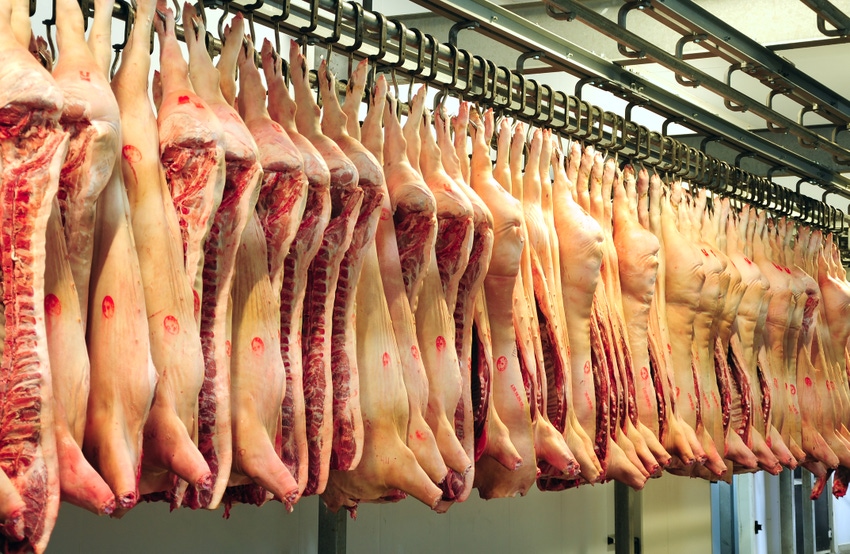Lawmakers ask for immediate action on pork harvest line speed
Economic power will shift to pork processors, impacting consumers and producers.

Seventy lawmakers joined Sen. Chuck Grassley (R-Iowa) and Reps. Jim Hagedorn, R-Minn., and Dusty Johnson, R-S.D., in letters asking the administration and the U.S. Department of Agriculture (USDA) to stop a recent court order from harming U.S. hog farmers. The letters call on Secretary of Agriculture Tom Vilsack and Acting Solicitor General Elizabeth Prelogar to appeal a recent federal district court striking down pork harvest facility line speeds allowed under the USDA’s New Swine Inspection System (NSIS).
“As the hog production cycle spans nearly a year, hogs set to enter this reduced-capacity market are already being raised. Farmers have little ability to alter their supply in the next year. Many farmers supplying these NSIS plants will need to find alternative destinations for their hogs,” The lawmakers explained in the letters. “The resulting surplus and reduced demand in a concentrated geographic region will shift economic power to pork processing companies. The culmination of economic losses from the producers selling their operation. By failing to act, USDA will drive consolidation in the pork industry.”
During a call Friday, Johnson noted that 20 years of data shows higher line speeds do not have an adverse effect on worker safety. The letters to the administration noted that USDA data comparing worker injury data between 2002 and 2010 shows that the NSIS program led to fewer worker injuries over time and fewer injuries when compared to their non-NSIS counterparts.
The concern right now, Johnson said on the call, is the impact the ruling will have on both consumers and producers as less pork will be processed in the country.
The goal is to get the decision appealed or to get an expedited rulemaking to get the line speeds back up, he added.
According to National Pork Producers Council (NPPC), the court order, set to go into effect on June 29, will lead to pork industry concentration and increased market power for plant operators at the expense of small hog farmers. As such, the group is calling for a longer stay of the court order and/or waivers that would allow the six impacted plants to continue operating at NSIS line speeds until a long-term solution acceptable to all industry stakeholders can be established.
The court decision will result in a 2.5% loss in pork packing plant capacity nationwide, and more than $80 million in reduced income for small U.S. hog farmers, according to an analysis by Iowa State University Economist Dr. Dermot Hayes. According to Hayes, the impact will be alarmingly high in Michigan and other states where lost capacity will be as high as 25%.
“We thank Sen. Grassley, Reps. Hagedorn and Johnson, and the 70 other members of Congress who signed onto this letter for their support of American hog farmers,” said NPPC President Jen Sorenson, communications director for Iowa Select Farms in West Des Moines, Iowa.
Sorenson added, “While the administration can appeal the court’s decision until the end of August, the damage to U.S. pork producers will be immediate. The operational changes impacted plants will be required to implement on June 29 will take time to unwind even if an appeal is filed before the end of August. It’s imperative that the administration act now to preserve industry competition and the livelihoods of small hog farmers.”
Pork industry economist Dr. Steve Meyer of Partners for Production Agriculture described the impact of the court’s decision as follows:
“The district court ruling reduces competition because the impacted plants will process fewer hogs, leaving more pigs available to other packers. Some of these hogs were purchased through negotiated trades, but others were procured through contract arrangements that may be altered or canceled in the face of lower capacity. Producers whose contracts are affected will likely have to accept lower values for their animals. Prices received by all producers may be reduced due to decreased competition. Impacted producers may also incur additional freight costs to move hogs to distant plants with available capacity. The situation will get significantly worse in the fourth quarter when the hog supply reaches its seasonal high.”
The NSIS, initiated during the Clinton administration and evaluated at five pilot plants over 20 years, was approved for industry-wide adoption in 2019. NSIS modernized an inspection system that had remained unchanged for more than 50 years. At a time when the United States needs more pork harvest capacity, the court order will reduce plant capacity at six plants running at NSIS line speeds by as much as 25%. The five original NSIS plants have been safely operating for more than 20 years.
Iowa State University livestock economist Lee Schulz said during a recent National Pork Board call this week that the line speed ruling will impact prices given the history of the industry. He noted the impact on prices every fourth quarter when the industry tests processing capacity as well as the price impacts seen during the COVID-19 pandemic challenges.
“Be it impacts in processing or greater numbers, [they] all have a detrimental on hog prices,” he said. “The industry is always fine-tuning processing capacity relative to inventory numbers. I think this is just one added factor there that can certainly impact prices. It’s something we’re certainly all watching.”
Other market analysts on the call expressed concern about the ruling but said they are waiting to see the outcome before decreasing their hog slaughter forecasts.
About the Author(s)
You May Also Like





